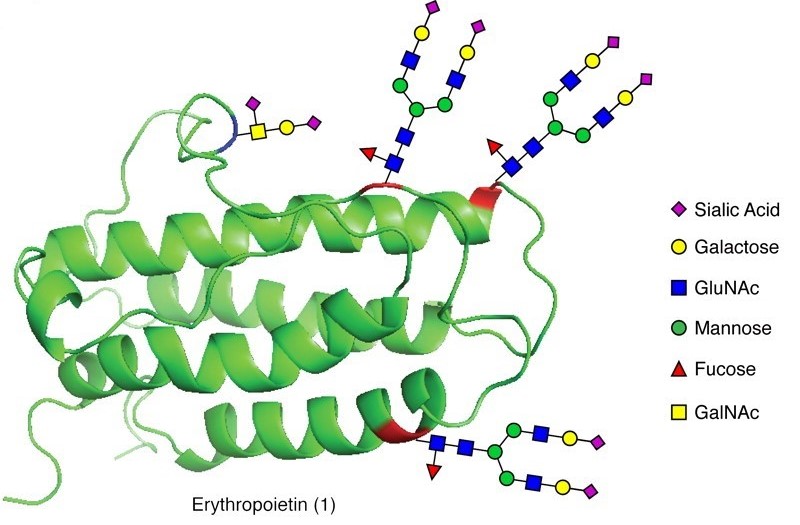What is EPO Protein
In the intricate realm of human biology, proteins play a pivotal role in maintaining homeostasis and orchestrating various physiological processes. Among the myriad proteins that contribute to the delicate balance within our bodies, the EPO protein stands out as a crucial player. EPO, or erythropoietin, is a glycoprotein hormone that holds paramount importance in regulating red blood cell production and maintaining overall health.
EPO is a pivotal glycoprotein hormone with a central role in maintaining homeostasis within the human body. Primarily synthesized in the kidneys and, to a lesser extent, in the liver, EPO functions as a regulator of red blood cell production, ensuring the optimal balance required for effective oxygen transport. This glycoprotein is encoded by the EPO gene, and its synthesis is triggered by hypoxia-inducible factors (HIFs) in response to low oxygen levels in the blood.
 Figure 1. Structure of EPO. (Brailsford, J.A., et al. 2012)
Figure 1. Structure of EPO. (Brailsford, J.A., et al. 2012)The Function of EPO Protein
At its core, the primary function of EPO lies in its regulation of erythropoiesis – the process by which red blood cells are produced in the bone marrow. In instances of low oxygen levels, such as those induced by high altitudes or conditions like anemia, the kidneys release EPO into the bloodstream. Acting on hematopoietic stem cells in the bone marrow, EPO stimulates their differentiation into mature red blood cells, ensuring an adequate supply to meet the body's oxygen demands. This process safeguards against hypoxia, a condition arising from insufficient oxygen supply to tissues.
EPO-Related Diseases
While EPO is indispensable for maintaining red blood cell homeostasis, disruptions in its production or signaling pathways can lead to various diseases. Polycythemia, characterized by an excess of red blood cells, can result from overproduction of EPO, often associated with kidney tumors or genetic mutations. Conversely, conditions causing low EPO levels, such as chronic kidney disease, can lead to anemia, characterized by fatigue, weakness, and reduced oxygen-carrying capacity.
EPO Related Signaling Pathways
Understanding the EPO signal pathway provides crucial insights into how this glycoprotein orchestrates erythropoiesis. In response to low oxygen levels, HIFs activate the EPO gene, leading to EPO synthesis. Upon release into the bloodstream, EPO binds to its receptors on hematopoietic stem cells, initiating a signaling cascade. Key players in this pathway include JAK2 and STAT5, which, upon activation, regulate gene expression in the nucleus, facilitating the differentiation of stem cells into red blood cells.
Applications of EPO in Biomedical Research
- Neuroprotective Effects
Research has illuminated EPO's neuroprotective potential, making it a candidate for conditions like stroke, traumatic brain injury, Alzheimer's, and Parkinson's disease. Its neurotrophic and anti-apoptotic properties, coupled with anti-inflammatory and anti-oxidative actions, suggest a broader therapeutic horizon in neurological disorders.
- Cardiovascular Medicine
In the realm of cardiovascular medicine, EPO emerges as a potential player in tissue repair post-myocardial infarction. Its ability to stimulate angiogenesis and inhibit apoptosis holds promise for enhancing cardiac recovery after ischemic events, presenting a novel avenue for cardiac therapeutics.
- Cancer Treatment
EPO's role in cancer treatment is a subject of intricate exploration. Some studies propose its potential anti-tumor effects and its ability to enhance the efficacy of certain cancer therapies. However, the complexities involved necessitate careful consideration of the balance between risks and benefits.
EPO stands as a multifaceted glycoprotein, intricately involved in the orchestration of red blood cell production and exhibiting remarkable potential in biomedical applications. From its pivotal role in preventing hypoxia to its promising implications in neuroprotection, cardiovascular medicine, and cancer treatment, EPO continues to captivate researchers and clinicians alike. As our understanding deepens and therapeutic strategies evolve, EPO's journey from a regulator of erythropoiesis to a versatile biomedical tool unfolds, offering new hope for improved treatments and patient outcomes.
Recommended Products for EPO Protein
| Cat.# | Species | Product name | Source (Host) | Tag |
|---|---|---|---|---|
| EPO-01H | Human | Recombinant Human Erythropoietin | Mammalian Cell | N/A |
| Epo-4376M | Mouse | Recombinant Mouse Epo Protein | Yeast | N/A |
| EPO-578R | Rat | Active Recombinant Rat EPO, His-tagged | Insect cells | His |
| EPO-904D | Dog | Recombinant Dog EPO Protein, His-tagged | E.coli | N-His |
| EPO-4368B | Bovine | Recombinant Bovine EPO Protein | Yeast | N/A |
| EPO-1196C | Cynomolgus Monkey | Active Recombinant Cynomolgus EPO Protein, His-tagged | HEK293 | His |
| EPO-2860H | Horse | Recombinant Horse EPO protein, His-SUMO-tagged | E.coli | His-SUMO |
| EPO-1487R | Rhesus Macaque | Recombinant Rhesus monkey EPO Protein, His-tagged | Mammalian Cell | His |
| EPO-3602Z | Zebrafish | Recombinant Zebrafish EPO | Mammalian Cell | His |
| EPO-605P | Pig | Recombinant Pig EPO protein, His & GST-tagged | E.coli | His/GST |
Reference
- Brailsford, J.A., Danishefsky, S.J. Probing the stability of nonglycosylated wild-type erythropoietin protein via reiterative alanine ligations. Proc Natl Acad Sci U S A. 2012, 109(19): 7196-201.

